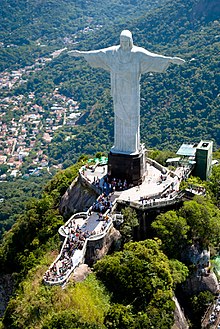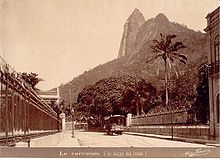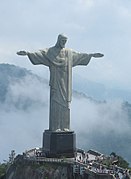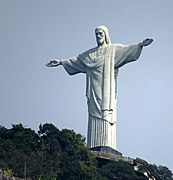Christ the Redeemer (statue)
 | |
 | |
| Coordinates | 22°57′7″S 43°12′38″W / 22.95194°S 43.21056°WCoordinates: 22°57′7″S 43°12′38″W / 22.95194°S 43.21056°W |
|---|---|
| Location | Corcovado mountain, Rio de Janeiro, Brazil |
| Designer | Designed by sculptor Paul Landowski and built by engineer Heitor da Silva Costa in collaboration with Albert Caquot. Sculptor Gheorghe Leonida created the face |
| Material | Soapstone |
| Width | 28 metres (92 ft) |
| Height | 30 metres (98 ft), 38 metres (125 ft) with its pedestal |
| Completion date | Dedicated October 12, 1931 |
| Consecrated October 12, 2006 New Seven Wonders of the World July 7, 2007 | |
National Historic Heritage of Brazil | |
| Designated | 2001 |
| Reference no. | 1478 |
Christ the Redeemer (Portuguese: Cristo Redentor, standard Brazilian Portuguese: [ˈkɾistu ʁedẽˈtoʁ], local pronunciation: [ˈkɾiɕtŭ̥ xe̞dẽˈtoɦ]) is an Art Deco statue of Jesus Christ in Rio de Janeiro, Brazil, created by French sculptor Paul Landowski and built by Brazilian engineer Heitor da Silva Costa, in collaboration with French engineer Albert Caquot. Romanian sculptor Gheorghe Leonida fashioned the face. Constructed between 1922 and 1931, the statue is 30 metres (98 ft) high, excluding its 8-metre (26 ft) pedestal. The arms stretch 28 metres (92 ft) wide.[1][2]
The statue weighs 635 metric tons (625 long, 700 short tons), and is located at the peak of the 700-metre (2,300 ft) Corcovado mountain in the Tijuca Forest National Park overlooking the city of Rio de Janeiro. A symbol of Christianity across the world, the statue has also become a cultural icon of both Rio de Janeiro and Brazil and was voted one of the New Seven Wonders of the World.[3] It is made of reinforced concrete and soapstone.[4][5][6]
History[]


Vincentian priest Pedro Maria Boss first suggested placing a Christian monument on Mount Corcovado in the mid 1850s to honor Princess Isabel, regent of Brazil and the daughter of Emperor Pedro II, but the project was not approved.[1] In 1889 the country became a republic, and owing to the separation of church and state the proposed statue was dismissed.[7]
The Catholic Circle[clarification needed] of Rio made a second proposal for a landmark statue on the mountain in 1920.[8] The group organized an event called Semana do Monumento ("Monument Week") to attract donations and collect signatures to support the building of the statue. The organization was motivated by what they perceived as 'Godlessness' in the society. The donations came mostly from Brazilian Catholics.[4] The designs considered for the "Statue of the Christ" included a representation of the Christian cross, a statue of Jesus with a globe in his hands, and a pedestal symbolizing the world.[9] The statue of Christ the Redeemer with open arms, a symbol of peace, was chosen.
Local engineer Heitor da Silva Costa and artist designed the statue.[10] French sculptor Paul Landowski created the work.[11]
In 1922, Landowski commissioned fellow Parisian Romanian sculptor Gheorghe Leonida, who studied sculpture at the Fine Arts Conservatory in Bucharest and in Italy.[12]
A group of engineers and technicians studied Landowski's submissions and felt building the structure of reinforced concrete (designed by Albert Caquot) instead of steel was more suitable for the cross-shaped statue. The concrete making up the base was supplied from Limhamn, Sweden.[13][14] The outer layers are soapstone, chosen for its enduring qualities and ease of use.[5] Construction took nine years, from 1922 to 1931, and cost the equivalent of US$250,000 (equivalent to $3,600,000 in 2020) and the monument opened on October 12, 1931.[5][6] During the opening ceremony, the statue was to be lit by a battery of floodlights turned on remotely by Italian shortwave radio inventor Guglielmo Marconi, stationed 9,200 kilometres (5,700 mi) away in Rome but because of bad weather, the lights were activated on-site.[8]
In October 2006, on the 75th anniversary of the statue's completion, Cardinal Eusebio Oscar Scheid, Archbishop of Rio, consecrated a chapel, named after Brazil's patron saint—Our Lady of the Apparition—under the statue, allowing Catholics to hold baptisms and weddings there.[6]
Lightning struck the statue during a violent thunderstorm on February 10, 2008, causing some damage to the fingers, head and eyebrows. The Rio de Janeiro state government initiated a restoration effort to replace some of the outer soapstone layers and repair the lightning rods on the statue. Lightning damaged it again on January 17, 2014, dislodging a finger on the right hand.[15][16][17][18]
In 2010, a massive restoration of the statue began. Work included cleaning, replacing the mortar and soapstone on the exterior, restoring iron in the internal structure, and waterproofing the monument. Vandals attacked the statue during renovation, spraying paint along the arm. Mayor Eduardo Paes called the act "a crime against the nation". The culprits later apologized and presented themselves to the police.[19][20][21]
In reference to Brazil striker Ronaldo's usual goal celebration of both arms outstretched, the Pirelli tyre company ran a 1998 commercial in which he replaced the statue while in an Inter Milan strip.[22] The commercial was controversial with the Catholic Church.[23]
Restoration[]





In 1990, several organizations, including the Archdiocese of Rio de Janeiro, media company Grupo Globo, oil company Shell do Brasil, environmental regulator IBAMA, National Institute of Historic and Artistic Heritage, and the city government of Rio de Janeiro entered into an agreement to conduct restoration work.
More work on the statue and its environs was conducted in 2003 and early 2010. In 2003, a set of escalators, walkways, and elevators were installed to facilitate access to the platform surrounding the statue. The four-month restoration in 2010[24] focused on the statue itself. The statue's internal structure was renovated and its soapstone mosaic covering was restored by removing a crust of fungi and other microorganisms and repairing small cracks. The lightning rods located in the statue's head and arms were also repaired, and new lighting fixtures were installed at the foot of the statue.[25]
The restoration involved one hundred people and used more than 60,000 pieces of stone taken from the same quarry as the original statue.[24] During the unveiling of the restored statue, it was illuminated with green-and-yellow lighting in support of the Brazil national football team playing in the 2010 FIFA World Cup.[24]
Maintenance work needs to be conducted periodically because of the strong winds and erosion to which the statue is exposed, as well as lightning strikes.[26] The original pale stone is no longer available in sufficient quantity, and replacement stones are increasingly darker in hue.[27]
Similar structures[]
This section needs additional citations for verification. (February 2020) |
- Christ the Protector in Encantado, Rio Grande do Sul, Brazil (43m)
- Christ the Redeemer in Rio Verde, Goiás, Brazil
- Christ in the Mount in Pitangui, Minas Gerais, Brazil
- Cristo del Otero in Palencia, Spain built in 1930 (21 m)
- Cristo Rey (statue, Mexico) located on the Cerro del Cubilete in Guanajuato, Mexico, inspired by Rio's Christ the Redeemer (23 m)
- Cristo Rey in Tenancingo, México, México (30 m)
- Christ Blessing in Manado, North Sulawesi, Indonesia (30 m)
- Christ of Havana in Havana, Cuba, inspired by Christ the Redeemer (20 m)
- Christ of the Abyss in various underwater locations
- Christ of the Ozarks in Arkansas, United States, inspired by Rio's Christ the Redeemer (20 m)
- Christ of Vũng Tàu in Vietnam (32 m)
- Christ the King in Świebodzin, Poland (33 m)
- Christ the Redeemer of the Andes (Argentina/Chile)
- Christ the Sacred Heart of Jesus, Ibiza, Spain, inspired by Christ the Redeemer (23 m)
- Cristo Blanco in Cusco, Peru
- Cristo de la Concordia in Cochabamba, Bolivia (34 m)
- Cristo de las Noas in Torreón, Mexico (22 m)
- Cristo del Pacífico in Lima, Peru, erected in 2011 (37 m)
- Patung Yesus Kristus[28] in Mansinam Island, West Papua, Indonesia (30 m)
- Cristo Redentore (Christ the Redeemer) of Maratea, Italy (21 m)
- Cristo Rei (Christ the King) in Almada, Portugal (28 m)
- Cristo Rei of Dili in Dili, Timor-Leste (27 m)
- Cristo Rei, Madeira on Madeira island, completed in 1927 (15 m)
- Cristo Rei in Lubango, Angola (14 m)
- Statue of Cristo Luz in Balneário Camboriú, Santa Catarina, Brazil
- Statue of Jesus Christ on the top of Sagrat Cor, Barcelona, Spain
- Tas-Salvatur, Malta (12 m)
- Statue of Jesus Christ, Monte Urgull, Donostia-San Sebastian, Spain - 12 m
- Jesus de Greatest in Imo, Nigeria, Africa's tallest statue of Jesus and fifth tallest statue on the continent (8.53 m)
- Cristo del Picacho in Tegucigalpa, Honduras
- Cristo Redentor, Puerto Plata, Dominican Republic
- Christ The King Lebanon
- Another imitation statue of Christ the Redeemer is at Nellore, Andhra Pradesh, India.(Shrish Patil)
- imitation at Kovalam, near Trivandrum, Kerala, India.
- Imitation at Ecopark, Kolkata, India.[29]
- Christ the Redeemer of Malacca is on the Portuguese Settlement Square in Melaka, Malaysia (20' tall)
- Cristo Rey in Colombia (26 m)
- Cristo Rey by Urbici Soler in Sunland Park, New Mexico - (8.83 M)
- Cristo Redentor (Barranca province, Lima, Peru)
- Cristo Rey Tijuanense, at Iglesia de San Martín de Porres near Colonia Los Álamos, Tijuana, Baja California, México (23 m 30 cm)
Gallery[]

The statue

Access escalators
Christ the Redeemer after restoration
The statue illuminated in yellow and green, the colors of Brazil, during the 2014 FIFA World Cup.

The Corcovado and Christ the Redeemer as seen from Sugarloaf Mountain.

Christ the Redeemer with moon in the background.

Christ at night
See also[]

1. Statue of Unity 240 m (790 ft) (incl. 58 m (190 ft) base)
2. Spring Temple Buddha 153 m (502 ft) (incl. 25 m (82 ft) pedestal and 20 m (66 ft) throne)
3. Statue of Liberty (Liberty Enlightening the World) 93 m (305 ft) (incl. 47 m (154 ft) pedestal)
4. The Motherland Calls 87 m (285 ft) (incl. 2 m (6 ft 7 in) pedestal)
5. Christ the Redeemer 38 m (125 ft) (incl. 8 m (26 ft) pedestal)
6. Michelangelo's David 5.17 m (17.0 ft) (excl. 2.5 m (8 ft 2 in) plinth)
- List of statues by height
References[]
- ^ Jump up to: a b Murray, Lorraine. "Christ the Redeemer (last updated 13 January 2014)". Encyclopædia Britannica. Retrieved July 11, 2014.
- ^ Giumbelli, Emerson (2014). Símbolos Religiosos em Controvérsia (in Portuguese). São Paulo. 244. ISBN 978-85-7816-137-8.
- ^ "The New Seven Wonders of the World". Hindustan Times. July 8, 2007. Archived from the original on September 30, 2007. Retrieved July 11, 2007.
- ^ Jump up to: a b "Christ the Redeemer". TIME. October 26, 1931. Archived from the original on September 30, 2007. Retrieved July 11, 2007.
- ^ Jump up to: a b c "Brazil: Crocovado mountain – Statue of Christ". Travel Channel. Archived from the original on May 16, 2007. Retrieved July 7, 2007.
- ^ Jump up to: a b c "Sanctuary Status for Rio landmark". BBC News. October 13, 2006. Retrieved July 7, 2007.
- ^ "Cristo Corcovado by Sergi Lla on Prezi". Prezi.com. Retrieved October 15, 2015.
- ^ Jump up to: a b "Cristo Redentor – Histórico da Construção" (in Portuguese). Archived from the original on March 13, 2009.
- ^ Victor, Duilo. "Redentor, carioca até a alma" (in Portuguese). Jornal do Brasil. Retrieved July 17, 2008.[permanent dead link]
- ^ "Arms Wide Open". bbc. Retrieved May 22, 2021.
- ^ "(Français) Paul Landowski - L'officiel sculpteur du Christ rédempteur". Retrieved February 2, 2020.
- ^ "Cristo Redentor: santuário carioca que virou símbolo da cidade no mundo" (in Portuguese). Prefeitura da Cidade do Rio de Janeiro. October 20, 2014.
- ^ "Skanska: Vi är oskyldiga till underverket".
- ^ "Öppna Kristusarmar som har haft skiftande betydelse - Kultur - Kristi…".
- ^ "Cristo Redentor vai passar por restauração até junho ("Christ the Redeemer under restoration 'til June")". Estadão.
- ^ Moratelli, Valmir. "Cristo Redentor, castigado por raios, passa por ampla reforma (Christ the Redeemer, punished by lightnings, go by ample refit)". . Archived from the original on April 4, 2010. Retrieved April 13, 2010.
- ^ "Cristo Redentor renovado para 2010" (PDF). Rio de Janeiro Government. December 2010.[permanent dead link]
- ^ "Lightning breaks finger off Rio's Christ". The Age. January 2014.
- ^ "Vandals cover Rio's Christ statue with graffiti". Reuters. April 16, 2010.
- ^ Tabak, Bernardo. "Estátua do Cristo Redentor é alvo de pichação". Globo.
- ^ Infosur hoy: Christ the Redeemer to get new outfit Archived July 14, 2014, at the Wayback Machine
- ^ "Pirelli e le metamorfosi della pubblicità". Corriere Della Sera. Retrieved September 19, 2018.
- ^ Squires, Nick (June 9, 2014). "World Cup 2014: Brazil furious over Christ the Redeemer statue in Rio de Janeiro in Italian football colours". Telegraph. Archived from the original on September 6, 2019. Retrieved October 20, 2020.
- ^ Jump up to: a b c "Brazil's Christ state returns after renovation". BBC News. July 1, 2010. Retrieved July 1, 2010.
- ^ Christ the Redeemer se la come, YouTube video, accessed January 20, 2011.
- ^ "Reforma no cartão-postal". . May 18, 2010. Archived from the original on January 27, 2010. Retrieved May 18, 2010.
- ^ Bowater, Donna; Mulvey, Stephen; Misra, Tanvi (March 10, 2014). "Arms wide open". BBC Online. Retrieved December 2, 2014.
- ^ Kompas Cyber Media (August 24, 2014). "Presiden Resmikan Patung Yesus Kristus di Pulau Mansinam – Kompas.com Regional". Regional.kompas.com. Retrieved October 15, 2015.
- ^ "Explore 'Seven Wonders of the World' at Eco Park near Kolkata". August 22, 2016.
Further reading[]
- Blanes, Ruy Llera (2014). "Review: Giumbelli, Emerson (2014), Símbolos Religiosos em Controvérsia. São Paulo: Terceiro Nome". Vibrant: Virtual Brazilian Anthropology (in Portuguese). 11 (2): 470–472. doi:10.1590/S1809-43412014000200016. ISSN 1809-4341.
- Giumbelli, Emerson (2008). "A modernidade do Cristo Redentor". Dados (in Portuguese). 51 (1): 75–105. doi:10.1590/S0011-52582008000100003. ISSN 0011-5258.
- Giumbelli, Emerson & Bosisio, Izabella (2010). "A Política de um Monumento: as Muitas Imagens do Cristo Redentor". Debates do NER (in Portuguese). 2 (18): 173–192. doi:10.22456/1982-8136.17638. ISSN 1982-8136.
- Giumbelli, Emerson (2013). "O Cristo Pichado". Ponto Urbe. Revista do Núcleo de Antropologia Urbana da USP (in Portuguese) (12). doi:10.4000/pontourbe.586. ISSN 1981-3341.
- Ranquetat-Júnior, Cesar Alberto (2012). Laicidade à brasileira: um estudo sobre a controvérsia em torno da presença de símbolos religiosos em espaços públicos (Doutorado em Antropologia Social) (in Portuguese). UFRGS. 310 pp. hdl:10183/54437.
- Ranquetat-Júnior, Cesar Alberto (2015). "Giumbelli, Emerson. Símbolos Religiosos em Controvérsia. São Paulo: Terceiro Nome, 2014". Debates do NER (in Portuguese). 1 (27): 429–437. doi:10.22456/1982-8136.56490. ISSN 1982-8136.
External links[]
| Wikimedia Commons has media related to Cristo Redentor do Rio de Janeiro. |
- Official website
- Corcovado Train
- Map (in Portuguese)
- Poliakoff, Martyn. "Soapstone @ Cristo Redentor". The Periodic Table of Videos. University of Nottingham.
- Map (in Portuguese)
- Christ the Redeemer (statue)
- 1931 sculptures
- Art Deco sculptures and memorials
- Buildings and structures completed in 1931
- Colossal statues of Jesus
- Concrete sculptures in Brazil
- Monuments and memorials in Rio de Janeiro (city)
- Mountain monuments and memorials
- National heritage sites of Rio de Janeiro (state)
- Outdoor sculptures in Brazil
- Stone sculptures in Brazil
- Vandalized works of art







